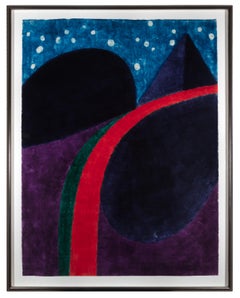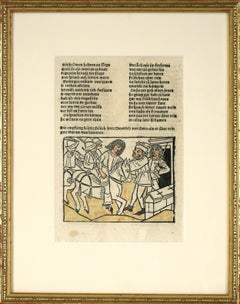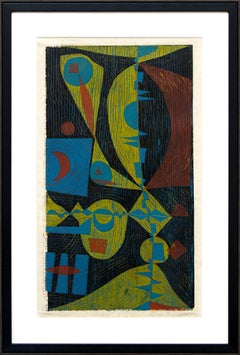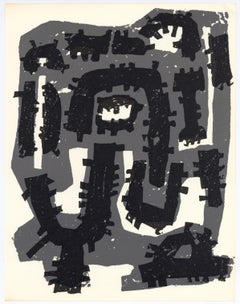Woodcut Prints and Multiples
Early 1900s Expressionist Woodcut Prints and Multiples
Woodcut
1970s Contemporary Woodcut Prints and Multiples
Woodcut
15th Century and Earlier Medieval Woodcut Prints and Multiples
Paint, Laid Paper, Woodcut
20th Century Abstract Geometric Woodcut Prints and Multiples
Woodcut
21st Century and Contemporary Contemporary Woodcut Prints and Multiples
Paper, Woodcut
1950s Woodcut Prints and Multiples
Woodcut
1840s Woodcut Prints and Multiples
Woodcut
Mid-20th Century Modern Woodcut Prints and Multiples
Woodcut
1970s Contemporary Woodcut Prints and Multiples
Woodcut
1850s Edo Woodcut Prints and Multiples
Woodcut
1980s Contemporary Woodcut Prints and Multiples
Woodcut
1980s Pop Art Woodcut Prints and Multiples
Lithograph, Screen, Woodcut, Paper
Mid-20th Century Modern Woodcut Prints and Multiples
Woodcut
Mid-20th Century Modern Woodcut Prints and Multiples
Woodcut
1960s Woodcut Prints and Multiples
Woodcut
Early 20th Century Modern Woodcut Prints and Multiples
Paper, Woodcut
1930s Bauhaus Woodcut Prints and Multiples
Woodcut
Late 19th Century Edo Woodcut Prints and Multiples
Watercolor, Handmade Paper, Woodcut
Late 19th Century French School Woodcut Prints and Multiples
Handmade Paper, Woodcut
1980s Abstract Woodcut Prints and Multiples
Woodcut
1940s Expressionist Woodcut Prints and Multiples
Woodcut
1880s Woodcut Prints and Multiples
Woodcut
1930s American Modern Woodcut Prints and Multiples
Woodcut
Early 20th Century Modern Woodcut Prints and Multiples
Woodcut
21st Century and Contemporary Woodcut Prints and Multiples
Woodcut
1920s Woodcut Prints and Multiples
Woodcut
1960s Abstract Expressionist Woodcut Prints and Multiples
Woodcut
1870s Modern Woodcut Prints and Multiples
Woodcut
1870s Modern Woodcut Prints and Multiples
Woodcut
1870s Modern Woodcut Prints and Multiples
Woodcut
20th Century Neo-Expressionist Woodcut Prints and Multiples
Woodcut
2010s Abstract Expressionist Woodcut Prints and Multiples
Woodcut
19th Century Modern Woodcut Prints and Multiples
Woodcut
1960s Modern Woodcut Prints and Multiples
Woodcut
1960s Modern Woodcut Prints and Multiples
Woodcut
1960s Modern Woodcut Prints and Multiples
Woodcut
1960s Modern Woodcut Prints and Multiples
Woodcut
1960s Modern Woodcut Prints and Multiples
Woodcut
1960s Modern Woodcut Prints and Multiples
Woodcut
19th Century Modern Woodcut Prints and Multiples
Woodcut
1920s Modern Woodcut Prints and Multiples
Woodcut
1930s Modern Woodcut Prints and Multiples
Woodcut
1950s Woodcut Prints and Multiples
Woodcut
Mid-19th Century Modern Woodcut Prints and Multiples
Woodcut
1910s Modern Woodcut Prints and Multiples
Woodcut
1920s Expressionist Woodcut Prints and Multiples
Woodcut
1950s Expressionist Woodcut Prints and Multiples
Woodcut
1960s Modern Woodcut Prints and Multiples
Woodcut
1960s Modern Woodcut Prints and Multiples
Woodcut
1960s Modern Woodcut Prints and Multiples
Woodcut
1960s Modern Woodcut Prints and Multiples
Woodcut
1960s Modern Woodcut Prints and Multiples
Woodcut
1960s Modern Woodcut Prints and Multiples
Woodcut
1960s Modern Woodcut Prints and Multiples
Woodcut
1960s Modern Woodcut Prints and Multiples
Woodcut
1960s Modern Woodcut Prints and Multiples
Woodcut
1990s Woodcut Prints and Multiples
Woodcut
Mid-20th Century Woodcut Prints and Multiples
Woodcut
1910s Woodcut Prints and Multiples
Color, Woodcut
1910s Abstract Expressionist Woodcut Prints and Multiples
Woodcut
Find Original Woodcut Prints for Your Home
Original woodcut prints and other types of fine art prints can help enhance any room in your home while supporting your effort to tie an interior design together.
Woodcut is a type of relief print that is made by carving a block of wood with a knife or gouge. The surface is then inked with a roller and pressed onto paper. Unlike with intaglio techniques, the section of the surface that has not been incised is what appears in the print.
Woodcut printmaking is one of the oldest printing techniques, first used in 9th-century China, mastered by Albrecht Dürer during the Northern Renaissance and famously associated with the ukiyo-e artists of 17th- and 18th-century Japan. (For concision, power and delight, it’s hard to beat a Japanese woodblock print, the product of an artistic tradition that is aging very well indeed.)
Elsewhere, German Expressionists like Emil Nolde and Ernst Ludwig Kirchner embraced the medium for its bold, graphic power in the 1920s, and artists continue to use it today.
OK, so what is the difference between a woodcut print and an intaglio print?
“[Intaglio] is the opposite of relief printing — woodcut, linoleum cut, letterpress, and rubber or metal stamping,” says Rhea Fontaine of Paulson Fontaine Press. “With relief printing, the raised areas of the printing surface are inked and printed, while the areas that have been cut away do not pick up the ink. Often these prints are made by hand.”
Find original woodcut prints by Katsushika Hokusai, Suzuki Harunobu, M.C. Escher, Mino Maccari and many other artists on 1stDibs.
Read More
Red Grooms’s 3D Tugboat Is a Chaotic, Comic Take on New York Life
The sculptural lithograph is part of the inimitable artist’s “Ruckus” series, now on view at the Brooklyn Museum.
Joan Mitchell’s Rare, Late-Career Diptych Buzzes with Life
Beneath the inky blackness, the painter’s irrepressible energy electrifies this pair of intaglio prints.
The 1stDibs Guide to Types of Abstract Art
Get to know the key movements and artists who have influenced visual culture for more than a century.
Romare Bearden’s Humanity Infuses His Bright, Bold Art
Through collage, painting and printmaking, the artist foregrounded Black life in America in revolutionary new ways.
Andy Warhol and Suzie Frankfurt’s ‘Wild Raspberries’ Cookbook Is an Artful, Fanciful Delight
This set of recipes and original prints might not make you a better chef. But it will make you smile.
Art Brings the Drama in These Intriguing 1stDibs 50 Spaces
The world’s top designers explain how they display art to elicit the natural (and supernatural) energy of home interiors.
Welcome (Back) to the Wild, Wonderful World of Walasse Ting
Americans are rediscovering the globe-trotting painter and poet, who was connected to all sorts of art movements across a long and varied career.
Shapero Modern’s Director Tells Us All about 20th-Century Prints
Tabitha Philpott-Kent knows a lot of art multiples. Here, the London gallery director talks about what makes printmaking so fabulous.




